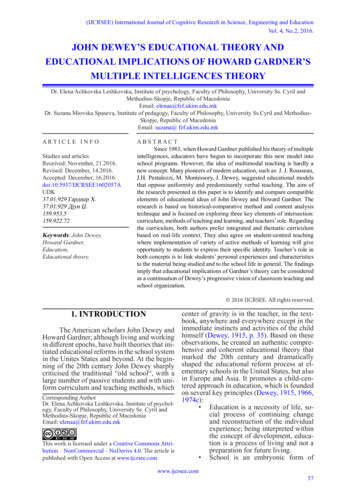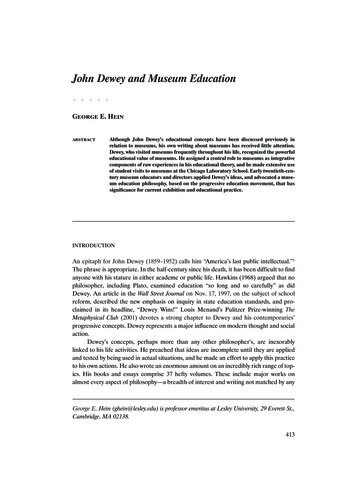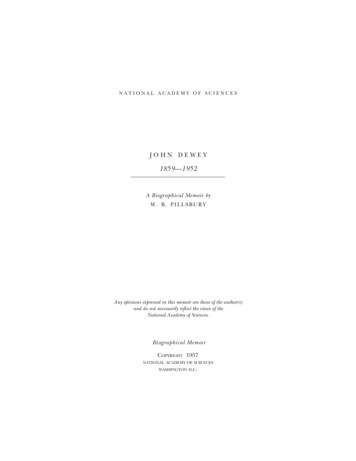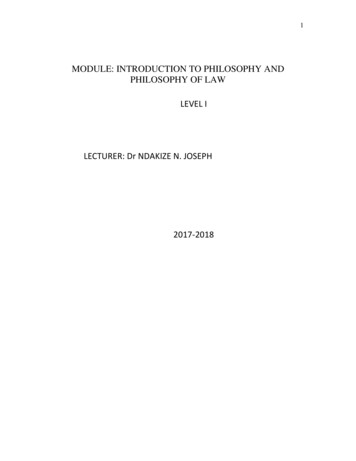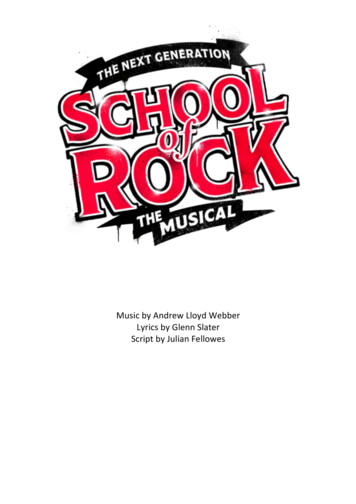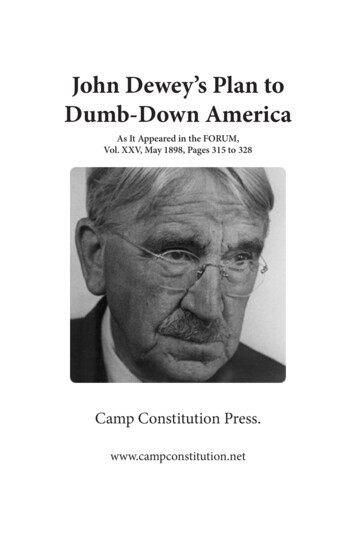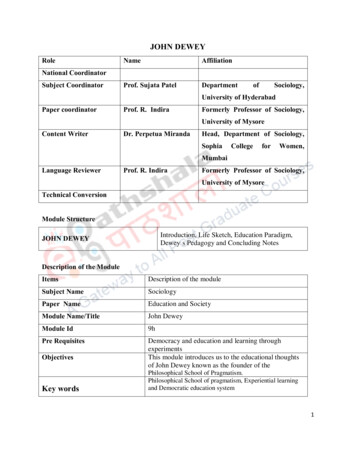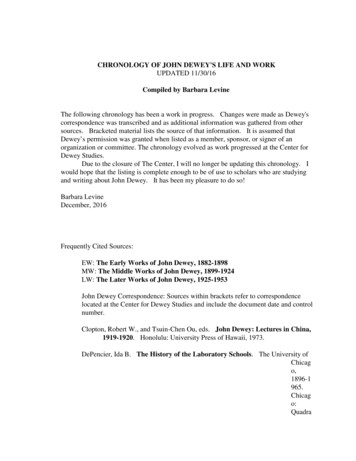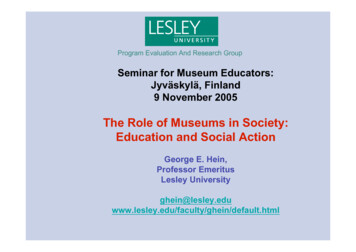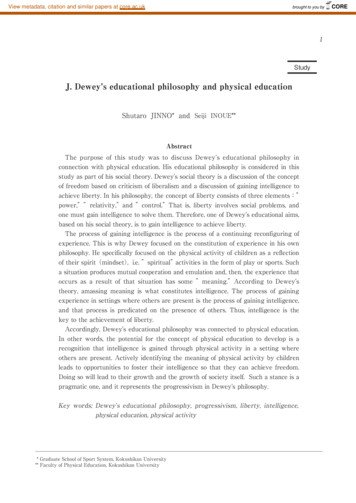
Transcription
View metadata, citation and similar papers at core.ac.ukbrought to you by1StudyJ. Dewey’s educational philosophy and physical educationShutaro JINNO* and Seiji INOUE**AbstractThe purpose of this study was to discuss Dewey’s educational philosophy inconnection with physical education. His educational philosophy is considered in thisstudy as part of his social theory. Dewey’s social theory is a discussion of the conceptof freedom based on criticism of liberalism and a discussion of gaining intelligence toachieve liberty. In his philosophy, the concept of liberty consists of three elements:”power,””relativity,”and ”control.”That is, liberty involves social problems, andone must gain intelligence to solve them. Therefore, one of Dewey’s educational aims,based on his social theory, is to gain intelligence to achieve liberty.The process of gaining intelligence is the process of a continuing reconfiguring ofexperience. This is why Dewey focused on the constitution of experience in his ownphilosophy. He specifically focused on the physical activity of children as a reflectionof their spirit(mindset),i.e. ”spiritual”activities in the form of play or sports. Sucha situation produces mutual cooperation and emulation and, then, the experience thatoccurs as a result of that situation has some ”meaning.”According to Dewey’stheory, amassing meaning is what constitutes intelligence. The process of gainingexperience in settings where others are present is the process of gaining intelligence,and that process is predicated on the presence of others. Thus, intelligence is thekey to the achievement of liberty.Accordingly, Dewey’s educational philosophy was connected to physical education.In other words, the potential for the concept of physical education to develop is arecognition that intelligence is gained through physical activity in a setting whereothers are present. Actively identifying the meaning of physical activity by childrenleads to opportunities to foster their intelligence so that they can achieve freedom.Doing so will lead to their growth and the growth of society itself. Such a stance is apragmatic one, and it represents the progressivism in Dewey’s philosophy.Key words; Dewey ’s educational philosophy, progressivism, liberty, intelligence,physical education, physical activity* Graduate School of Sport System, Kokushikan University** Faculty of Physical Education, Kokushikan UniversityCORE
2JINNO & INOUE1.IntroductionAfter World War II, Japan accepted American educational philosophies as a basis for educationalreform. One of those philosophies was Pragmatism1).Recently, studies have tended to re-evaluatePragmatism, and this is particularly evident in disciplines following social practices such asenvironmental ethics and political science in parallel with pedagogy;this tendency is based on thestance that Pragmatism takes with respect to social problems2).In the current tendency tore-evaluate Pragmatism, great interest in the philosophy of John Dewey(1859 1952),a pragmatist,may have relevance to the current educational problems.Historically, educational philosophy has been child-centered. This philosophy was inspired byProgressivism seen in early 20th century America. As a pragmatist, Dewey is regarded as a centralfigure in the child-centered educational philosophy, backed by Progressivism, and he is oftenemphasized as a counterpart to traditional educational philosophy, which is not a legitimateunderstanding of his educational philosophy. Of course, Dewey’s educational philosophy has a specialview of children, but it demands a restructuring of attitudes towards educating children in diversecircumstances. Therefore, Dewey’s educational philosophy is a pragmatic stance that empirically andactively deals with diverse educational problems with ideals.In order to understand Dewey’s attitude toward education, his entire philosophy needs to beunderstood. Dewey devised his philosophy as a hierarchy of three key concepts:“the individual,”“the community,”and“society”3).Dewey’s concept of growth runs through these concepts. Heviewed“growth”as visible changes in society and human beings living in it as well as an invisibletransformation, i.e.“constructive growth through liberty on the road to the future.”4) Dewey’sthoughts on“freedom”have been discussed as a social theory beyond the scope of educationaltheory.“The theory of democracy,”which is the thrust of Dewey’s philosophy, is a vast topic thatincludes educational philosophy and social theory. In these ways of thinking, Dewey explored thenature of society5).Divining Dewey’s theory of society should help understand the educationalphilosophy contained therein. It should also help understand the“theory of democracy”that hedevised.Therefore, Dewey’s progressivism should be regarded as“a request for a stance on a way of lifewith an eye toward the growth of society”rather than“advocacy for an educational philosophy thatdiffers from traditional educational philosophy.”As Pragmatism is being reevaluated, Dewey’seducational philosophy must be discussed with respect to current educational problems.2.Purpose of studyThe purpose of this study was to examine Dewey’s educational philosophy, and especially his ideaof a child-centered educational philosophy, in connection with physical education.
J. Dewey’s educational philosophy and physical education33.Dewey’s philosophy and the child-centered educational philosophyThe child-centered educational philosophy is as an educational philosophy that promoted theprogressive education movement in the United States from the end of the 19th century to thebeginning of the 20th century. At the time, the child-centered educational philosophy was aprogressive movement that aimed to transition from traditional education to progressive education,and that philosophy garnered attention as“New Education”6).The child-centered educationalphilosophy was based on the idea of ascertaining the current state of children and developingeducation that is appropriate for children7).The child-centered educational philosophy originatedfrom the educational theories of Pragmatism, and particularly Dewey’s philosophy 8).The childcentered educational philosophy also appeared from the 18th century to the early 19th century. Thechild-centered educational philosophy was developed by proponents such as J. Rousseau(1712 1778),J. Pestalozzi(1746 1827),and F. Fröbel(1782 1852)9).Dewey’s educational philosophy hasa special view of children, and child-centered education in the United States is said to have begun at10)the laboratory school where Dewey’s educational philosophy was practiced(1896-1904).E. Kay(Ellen Karolina Sofia Key, 1849 1926)was also a prominent proponent of a child-centerededucational philosophy. As Kay explained:But the end of all instruction in college, as in the school, should not consist in examinations anddiplomas;these must be obliterated from the face of the earth. The aim should be that thescholars themselves, at first hand, should acquire their knowledge, should get their impressions,should from their opinions, should work their way through to intellectual tastes, not as they nowdo, taking no trouble themselves, but being supposed to acquire these gifts through interestinglectures given by the teacher on five different subjects, heard every morning while the studentsare dozing, and soon forgotten.11)“New Education”based on the child-centered educational philosophy also affected the philosophyof physical education, and it created a movement known as“New Physical Education.”New PhysicalEducation aimed to transition from nation-centered physical education to physical education basedon child-centered educational perspectives12).New Physical Education was organized by three people,13)T. D. Wood(1865 1951),C. W. Hetherington(1870 1942),and L. H. Gulick(1865 1918).The introduction of“New Education”from the United States into Japan was the beginning ofpostwar educational reform. The physical education movement revised educational methods such asstandardized classes and the emphasis on vertical relationships between teachers and students, andit provided a basis for the philosophy of“New Physical Education”that recommended a democraticsystem of education14).However, the child-centered view of education was evident in physicaleducation before the physical education movement arose. As an example, the child-centered physical15)education movement resisted physical education based on nationalism in 1917(Taisho 6).At thetime, however, the methodology of child-centered physical education was incomplete and child-
4JINNO & INOUEcentered physical education could not be put into practice. Child-centered physical educationgarnered attention again as a result of educational reforms after World War II. The philosophy of“education of the body”was dismantled, and the concept of“education through physical activity”was introduced16).As the concepts of education and physical education swung back and forth, thechild-centered educational philosophy again garnered attention from time to time. Physicaleducation that reflects the child-centered educational philosophy has been influenced by Dewey’sphilosophy. However, understanding the educational philosophy in Dewey’s philosophy as simply achild-centered educational philosophy may not be a legitimate interpretation. In order to examineDewey’s educational philosophy, Dewey’s social philosophy must be examined since it is the contextfor Dewey’s educational philosophy.According to Dewey, the society of the 1920s and 1930s seemed to“consist of various conditionsthat would adversely affect all democratic freedoms.”Social change meant the disruption of aphilosophy, the concept of liberty(i.e. the disruption of economic individualism)that contrasted toliberalism at the time17).The reason why Dewey criticized the liberalism of the time based on historywas because of the dominant belief that“enterprises pursue profit,”substantiating the capitalistsystem at the time. In addition,“certain societal conditions”for liberty, which as the supposed goalof liberalism, were not considered important. Dewey insisted on the need for humans to changethrough an understanding of humanity itself and education, rather than altering the social systemsthat tend to garner attention during social transformation18).The next section examines the socialtheory found in Dewey’s philosophy. The focus of Dewey’s rethinking of liberalism as a social theorywas to explore how to achieve liberty in one’s life, rather than to question the concept of libertyitself19).In other words, the focus of Dewey’s rethinking of liberalism was how to actually achievefreedom20).In general, liberalism is defined as follows:① Liberalism:The holding of liberal opinions in politics or theology;the political tenetscharacteristic of a liberal.21)② Liberalism:liberal opinions or principles, especially with regard to social and political matters.22)The concept of liberty in Dewey’s philosophy can be examined while setting aside the concept ofliberalism as it is generally understood. Dewey explains“liberty”as follows:Well, in the first place, liberty is not just an idea, an abstract principle. It is power, effectivepower to do specific things. There is no such things as liberty in general;liberty, so to speak, atlarge. If one wants to know what the condition of liberty is at a given time, one has to examinewhat persons can do and what they cannot do. ・・・(omission)・・・.In the second place, the possession of effective power is always a matter of the distribution ofpower that exists at the time. ・・・(omission)・・・. There is no such thing physically as manifestationof energy or effective power by one thing except in relation to the energy manifested by otherthings. There is no such thing as the liberty or effective power of an individual, group, or class,
J. Dewey’s educational philosophy and physical education5except in relation to the liberties, the effective powers, of other individuals, groups, and class.・・・(omission)・・・.In the third place, this relativity of liberty to the existing distribution of powers of action, whilemeaning that there is no such thing as absolute liberty, also necessarily means that whateverthere is liberty at one place there is restraint at some other place. The system of liberties thatexists at any times is always the system of restrains or controls that exists at that time. No onecan do anything except in relation to what others can do and cannot do.23)Liberty is power. Liberty is manifested in the community, and thus relative. That power isaccompanied by control. According to Dewey, intelligence is the key to securing liberty:Of course, there are conflicting interests; otherwise there would be no social problems. Theproblem under discussion is precisely how conflicting claims are to be settled in the interest of thewidest possible contribution to the interests of all or at least of the great majority. The methodof democracy insofar as it is that of organized intelligence is to bring these conflicts out intothe open where their special claims can be seen and appraised, where they can be discussed andjudged in the light of more inclusive interests than are represented by either of them separately.24)In other words, liberty is controlled by and achieved through intelligence. In Dewey’s philosophy,“intelligence”is explained as follows:In its large sense, this remarking of the old through union with the new is precisely whatintelligence is. It is conversion of past experience into knowledge and projection of that knowledgein ideas and purposes that anticipate what may come to be in the future and that indicate how torealize what is desired.25)The relationship between intelligence and experience as Dewey described it has great significancein Dewey’s philosophy, and this point will be discussed later. Dewey believed that education isneeded to achieve freedom through intelligence(a renascent liberalism):Its work(*the work of Liberalism)is first of all education, in the broadest sense of that term.Schooling is a part of the work of education, but education in its full meaning includes all theinfluences that go to form the attitudes and dispositions(of desire as well as of belief),whichconstitute dominant habits of mind and character.26)Dewey’s educational philosophy is typified by the following passage:When, then, I say that the first object of a renascent liberalism is education, I mean that its taskis to aid in producing the habits of mind and character, the intellectual and moral patterns, that
6JINNO & INOUEare somewhere near even with the actual movements of events.27)Thus, Dewey’s social theory is connected to his theory of education for children. Therefore, thenext section will examine Dewey’s educational theory.4.The theory of education for children in Dewey’s philosophyThe philosophy of education for children in Dewey’s philosophy was evident in the philosophy ofDewey’s educational efforts at the laboratory school(1896 1904)of the University of Chicago from1896 to 1903. For example, Dewey states that:The school is a special social community in which the too complex social environment isreduced and simplified; in which certain ideas and facts concerning this simplified social life arecommunicated to the child; in which, also, the child is called upon to undertake not all kinds ofactivity, but those specially selected on the ground of peculiar adaptation to the child.28)Thus, in Dewey’s educational philosophy there is a link between children and society, and aspecial view of children is apparent. This article will now look at a passage that readily identifies thephilosophy of education for children in Dewey’s philosophy. This passage is why the educationalphilosophy found in Dewey philosophy is so readily perceived as a child-centered educationalphilosophy:It(*the old education)may be summed up by stating that the center of gravity is outside thechild. It is in the teacher, the textbook, anywhere and everywhere you please except in theimmediate instincts and activities of the child himself. ・・・(omission)・・・. Now the change, which iscoming into our education, is the shifting of the center of gravity. It is aching, a revolution, notunlike that introduced by Copernicus when the astronomical center shifted from the earth to thesun. In this case the child becomes the sun about which the appliances of education revolve; he isthe center about which they are organized.29)In other words, Dewy sought to develop a form of education that encourages children to activelyinquire rather than a form of education that deals with them passively and that treats them enmasse as an aggregate of units30).The reason is expressed in the following words from Dewey:The moment children act they individualize themselves; they cease to be a mass, and becomethe intensely distinctive beings that we are acquainted with out of school, in the home, the family,on the playground, and in the neighborhood.31)Children are very active beings, and in the blink of an eye they become individuals. Children’s
J. Dewey’s educational philosophy and physical education7actions are related to their instincts. According to Dewey, children like to express themselves bymeans such as form(e.g. body work)and color. When left to their own devices to pursue their owninterests, children with grow in some manner. However, this growth is“merely accidental”32).“Butlet the child first express his impulse, and then through criticism, question, and suggestion bring himto consciousness of what he has done, and what he needs to do, and the result(as growth)is quite33)different”.Children experience various things in their daily lives. Therefore, this article will consider theconcept of experience in Dewey’s philosophy. According to Dewey, experience consists of an activeelement, i.e. a“trying”or experimenting, and a passive element, an“undergoing”or consequence34).When, for example, a child thrusts his finger into a flame, this action alone cannot be consideredexperience. Experience occurs when the child’s action(“trying”)is linked to his suffering itsconsequences(“undergoing”).In other words, an action that has“meaning”is considered anexperience35).Dewey is focusing on the human“mind”as he considers finding meaning from an experience36).Dewey classifies education into two categories, providing children with rich experiences and thedirect absorption of knowledge. According to Dewey, the latter severs something which is calledmind or consciousness from the physical organs of activity, resulting in mere bodily action. Instead,Dewey thinks that directly ascertaining knowledge through“spiritual”activity is worthwhile. Atleast in part, the following passage expresses Dewey’s view of the mind-body relationship:It is, I repeat, the split between the latter as they have externally occurred and the ways ofdesiring, thinking, and putting emotion and purpose into execution that is the basic cause ofpresent confusion in mind and paralysis in action. ・・・(omission)・・・. Thought, desire and purposeexist in a constant give and take of interaction with environing conditions. But resolute thought isfirst step in that change of action that will itself carry further the needed change in patterns ofmind and character.37)The“mind”is directly linked to instincts, impulses, and interests, and a child’s“mind”isexpressed through activity. That is, activity is a reflection of the mindset of children, and activity ishow children express their own inner world. According to Dewey, the nervous tension and fatiguethat can develop in children and educators are inevitable consequences of an abnormal situation inwhich bodily activity is separate from the perception of meaning.In light of the points identified thus far, when children concentrate on something they are merelyexpressing the concept of liberty, which is the“effective power to do specific things.”In otherwords, the activity through which children express their interests, mindset, and instincts is thepublic expression of power, i.e. liberty, by children. When children do so, they learn the“meaning”ofbeing part of society through their interaction with their environment. As Dewey explained:The fundamental factors in the educative process are an immature, undeveloped being;and
8JINNO & INOUEcertain social aims, meanings, values incarnate in the matured experience of the adult. Theeducative process is the due interaction of these forces. Such a conception of each in relation tothe other as facilitates completest and freest interaction is the essence of educational theory.38)Thus, Dewey is not looking solely at the body and its superficial physical interaction with theenvironment. Instead, he has focused on“the meaning”of activity, i.e. what occurs in the child’sinvisible spiritual world. This article will now attempt to connect Dewey philosophy as it has beendescribed thus far to physical education.When attempting to connect Dewey’s educational philosophy and theories to physical education,one should imagine what children are thinking and how they should behave. Thus, one should lookat the following passage from Dewey:Upon the playground, in game and sport, social organization takes place spontaneously andinevitably. There is something to do, some activity to be carried on, requiring natural divisions oflabor, selection of leaders and followers, mutual cooperation and emulation.39)Therefore, the various activities that children engage in may be casual, but they should not bedisregarded. Children engage in various activities with their bodies, and that action is educationallysignificant. Dewey’s views on play and games warrant attention:Play is not to be identified with anything which the child externally does. It rather designateshis mental attitude in its entirety and in its unity. It is the free play, the interplay, of all the child’s powers, thoughts, and physical movements, in embodying, in a satisfying form, his own imagesand interests.40)Children’s physical activity is directly connected to their inner world. In the community, childrenlearn and gain intelligence by encountering various people, ideas, and surroundings. Dewey’s theoryof society should be looked at once again. The existence of others is a prerequisite to achievingliberty, and intelligence is the key to its achievement. The way that children should behave, whichDewey focused on, was limited to settings where children sought to“control”the freedom of theirplaymates or teammates. However, the events that transpired in the settings that Dewey focused onwere mostly accidental, as he also mentioned. Therefore, the mission of education is to consciouslyencourage experiences through such events and to make children aware that they are changingduring those events and that they should seek to gain something from those experiences. In light ofthis educational philosophy and theory, what can physical education do? As Kimura explained:Bring about events where people come into contact with one another between a person and aperson and teach students about“co-existing.”Being aware of the existence of others allows oneto be aware of one’s own existence, and one is enriched by accepting others. This does not mean
J. Dewey’s educational philosophy and physical education9learning abstract moral codes but learning with one’s body.This opens the door to physicaleducation41).The existence of“others”should be a major prerequisite of physical education, and physicaleducation must begin with a renewed awareness of the existence of“others.”Physical education isgrounded in humans seeking to gain intelligence.“Physical knowledge”is on par with“professionalknowledge,”“practical knowledge,”and“empirical knowledge,”so physical education can bedescribed as“teaching physical knowledge.”Shinohara described a social framework that fostered“knowledge”as a“theater of knowledge.”When gaining physical knowledge, the body is both thesubject of study and the means with which to gain knowledge. Thus, Shinohara stated that linguisticknowledge held in the brain is not expressed solely through symbols and language. As he explained:Physical knowledge must be embodied in a“theater of knowledge,”i.e. being able to sense,feeling, and express knowledge with one’s body. Discussion is an exchange of linguistic knowledge,and discussion provides a rich education. Similarly, physical activity and expression is an exchangeof physical knowledge, and one receives a richer physical education through physical activity andexpression.42)According to Shinohara, the social framework that fosters“knowledge”is a“theater ofknowledge,”and this framework fosters an“intelligent mind”as well as an“intelligent body”(i.e.physical education)through transactions43).That is, knowledge is used effectively by the intellect.This idea applies to activity involving the body as it does to use of language. This also leads to“thephysical rebellion of contemporary children”mentioned by Kimura. As cited earlier, Dewey assertedthat“the split between the latter as they have externally occurred and the ways of desiring,thinking, and putting emotion and purpose into execution that is the basic cause of present confusionin mind and paralysis in action.”This passage warrants consideration today as well. Children live ina community where other people are present, and both have their own philosophies. Children havecertain meaningful experiences as a result of sensing their surroundings with their bodies. Childrenalso learn the significance of physical activity and how to interact with others. This is the basis forintelligence fostered through physical education.The discussion thus far has sought to describe personal growth promoted by intelligence and thegrowth of a society consisting of individuals. The concept of growth in physical education refers tophysical development and maturity, but it should also be regarded as transformation or growth ofthe inner spiritual world of a corporeal individual44).As Dewey explained:In every integral experience there is form because there is dynamic organization. I call theorganization dynamic because it takes time to complete it, because it is a growth.45)The concept of growth in Dewey’s philosophy should be considered carefully today, given the
10JINNO & INOUErapid and complex changes in society. The educational significance of physical education is notlimited to encounters with physical exercise or promoting physical development and health. Instead,casual activities also have educational significance. Once one recognizes that there are invisibleimplications associated with the various activities of children(however casual they may be),oneunderstands the unlimited potential for their growth and the growth of society. Dewey’s philosophyis considered to be a humanistic theory of education46).Therefore, physical education predicated onDewey’s philosophy can be described as an educational endeavor to foster“humanistic intelligence.”Dewey’s progressivism is based on a pragmatic stance that actively looks to the future whileensuring the growth of children and society.5.ConclusionThe purpose of this study was to examine Dewey’s educational philosophy based on his socialphilosophy and to consider the connection between his educational philosophy and physicaleducation. Dewey’s social philosophy specifically addresses“the issue of liberty,”and Dewey statedthat intelligence was needed in order to achieve liberty. In other words, he regarded intelligence asthe ability to consider how freedom can be achieved in light of the existence of others. Dewey alsocontended that education was needed to gain intelligence. If the physical activity of children isviewed from an educational standpoint, that activity is important and cannot be overlooked.Experience is the basis for intelligence, so experience is needed to foster intelligence.Dewey’s educational philosophy and physical education were connected in the following manner.Physical activity is the basis for sensing the world firsthand and controlling the power, i.e. freedom,that one is able to exercise. Knowledge of how the world is constructed and how one must live andthe ability to effectively use that knowledge are fostered through physical activity. This makesindividuals aware of themselves and others, it teaches individuals what they and others want, and itallows an individual to grow in various settings.Physical education is taught to children, and the physical activity of children changes each day. Insuch instances, teachers of physical education must be aware of the individuality of their studentsand they need to accommodate their teaching to the situation. Physical education must view peopleas they are at a given moment. This is a pragmatic stance that actively deals with issues in a giveninstance, and it truly embodies Dewey’s progressivism.References1) SHIMONAKA, Hiroshi ed.(1992)Pragmatism & education of pragmatism, in“Testugaku Jiten[Dictionaryof Philosophy]”,HEIBON SYA, pp.1205-1206.(in Japanese)/ The philosophy of pragmatism was said tohave been established by CS Peirce(1839 1914),W. James(1842 1910),Dewey et al. The trend wascarried on by GH Mead(1863 1931)and R. Rorty(1931 2007).According to pragmatism, our livesmean that we interact with the environment and maintain harmony through our actions and experiences.Distortion of this interaction is regarded as a“problem,”and balance is restored(the problem is resolved)through further actions and experiences. Pragmatism’s view of education is the altering and expansion of
J. Dewey’s educational philosophy and physical education11actions and experience.2) ITO, Kunitake(2015)Konnichi no pragmatism no ichisokumen[One aspect of today’s pragmatism],in“KURIHARA, Kazuki ed.(2015)Gendai shisou 7 vol. 43-11 tokusyu:ima naze pragmatism ka[ModernThought 7 vol. 43-11 Special Edition
Dewey’s educational philosophy, Dewey’s social philosophy must be examined since it is the context for Dewey’s educational philosophy. According to Dewey, the society of the 1920s and 1930s seemed to “consist of various conditions that would adversely affect all demo
